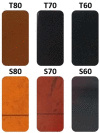Novel HMO-Glasses with Sb2O3 and TeO2 for Nuclear Radiation Shielding Purposes: A Comparative Analysis with Traditional and Novel Shields
- PMID: 34361524
- PMCID: PMC8348751
- DOI: 10.3390/ma14154330
Novel HMO-Glasses with Sb2O3 and TeO2 for Nuclear Radiation Shielding Purposes: A Comparative Analysis with Traditional and Novel Shields
Abstract
The radiation shielding characteristics of samples from two TeO2 and Sb2O3-based basic glass groups were investigated in this research. TeO2 and Sb2O3-based glasses were determined in the research as six samples with a composition of 10WO3-(x)MoO3-(90 - x)(TeO2/Sb2O3) (x = 10, 20, 30). A general purpose MCNPX Monte Carlo code and Phy-X/PSD platform were used to estimate the radiation shielding characteristics. Accordingly, the linear and mass attenuation coefficients, half value layer, mean free path, variation of the effective atomic number with photon energy, exposure and built-up energy factors, and effective removal cross-section values were determined. It was determined that the results that were produced using the two different techniques were consistent. Based on the collected data, the most remarkable findings were found to be associated with the sample classified as T80 (10WO3 + 10MoO3 + 80TeO2). The current study showed that material density was as equally important as composition in modifying radiation shielding characteristics. With the T80 sample with the greatest density (5.61 g/cm3) achieving the best results. Additionally, the acquired findings were compared to the radiation shielding characteristics of various glass and concrete materials. Increasing the quantity of MoO3 additive, a known heavy metal oxide, in these TeO2 and Sb2O3-based glasses may have a detrimental impact on the change in radiation shielding characteristics.
Keywords: HMO glasses; Sb2O3; TeO2; radiation shielding.
Conflict of interest statement
The authors declare no conflict of interest.
Figures















References
-
- Ramesh P., Gangareddy J., Sathish K.N., Pramod A.G., Hegde V., Pasha U.M., Khan S., Annapurna K., Sayyed M.I., Abdullah A.M.S., et al. Effect of heavy metal oxides on photoluminescence and spectroscopic attributes of Eu3+ activated borate glasses. Opt. Mater. 2021;114:110933. doi: 10.1016/j.optmat.2021.110933. - DOI
-
- Alharbi T., Mohamed H.F.M., Saddeek Y.B., El-Haseib A.Y., Shaaban K.S. Study of the TiO2 effect on the heavy metals oxides borosilicate glasses structure using gamma-ray spectroscopy and positron annihilation technique. Radiat. Phys. Chem. 2019;164:108345. doi: 10.1016/j.radphyschem.2019.108345. - DOI
-
- Ersundu M.Ç., Ersundu A.E., Sayyed M.I., Lakshminarayana G., Aydin S. Evaluation of physical, structural properties and shielding parameters for K2O–WO3–TeO2 glasses for gamma ray shielding applications. J. Alloys Compd. 2017;714:278–286. doi: 10.1016/j.jallcom.2017.04.223. - DOI
-
- Ersundu M.Ç., Ersundu A.E., Gedikoğlu N., Şakar E., Büyükyıldız M., Kurudirek M. Physical, mechanical and gamma-ray shielding properties of highly transparent ZnO-MoO3-TeO2 glasses. J. Non-Cryst. Solids. 2019;524:119648. doi: 10.1016/j.jnoncrysol.2019.119648. - DOI
-
- Al-Hadeethi Y., Sayyed M.I. Analysis of borosilicate glasses doped with heavy metal oxides for gamma radiation shielding application using Geant4 simulation code. Ceram. Int. 2019;45:24858–24864. doi: 10.1016/j.ceramint.2019.08.234. - DOI
LinkOut - more resources
Full Text Sources

